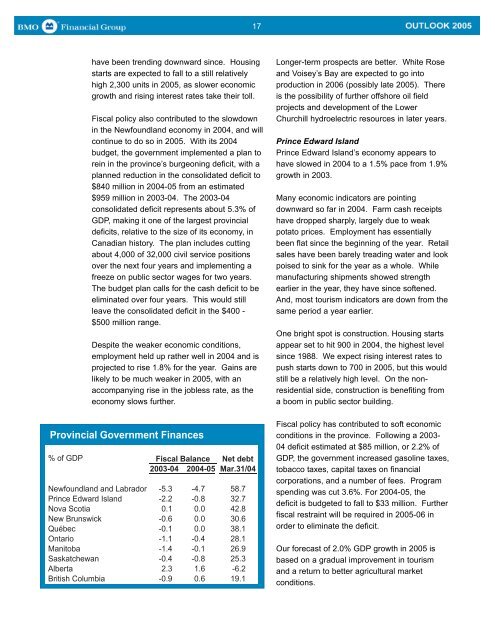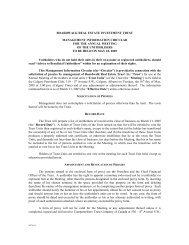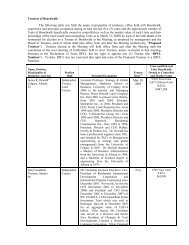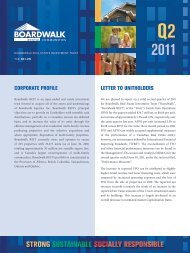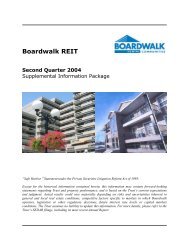BMO Financial Group - Outlook 2005(1.1Mb pdf File) - Boardwalk REIT
BMO Financial Group - Outlook 2005(1.1Mb pdf File) - Boardwalk REIT
BMO Financial Group - Outlook 2005(1.1Mb pdf File) - Boardwalk REIT
Create successful ePaper yourself
Turn your PDF publications into a flip-book with our unique Google optimized e-Paper software.
17<br />
have been trending downward since. Housing<br />
starts are expected to fall to a still relatively<br />
high 2,300 units in <strong>2005</strong>, as slower economic<br />
growth and rising interest rates take their toll.<br />
Fiscal policy also contributed to the slowdown<br />
in the Newfoundland economy in 2004, and will<br />
continue to do so in <strong>2005</strong>. With its 2004<br />
budget, the government implemented a plan to<br />
rein in the province’s burgeoning deficit, with a<br />
planned reduction in the consolidated deficit to<br />
$840 million in 2004-05 from an estimated<br />
$959 million in 2003-04. The 2003-04<br />
consolidated deficit represents about 5.3% of<br />
GDP, making it one of the largest provincial<br />
deficits, relative to the size of its economy, in<br />
Canadian history. The plan includes cutting<br />
about 4,000 of 32,000 civil service positions<br />
over the next four years and implementing a<br />
freeze on public sector wages for two years.<br />
The budget plan calls for the cash deficit to be<br />
eliminated over four years. This would still<br />
leave the consolidated deficit in the $400 -<br />
$500 million range.<br />
Despite the weaker economic conditions,<br />
employment held up rather well in 2004 and is<br />
projected to rise 1.8% for the year. Gains are<br />
likely to be much weaker in <strong>2005</strong>, with an<br />
accompanying rise in the jobless rate, as the<br />
economy slows further.<br />
Provincial Government Finances<br />
% of GDP Fiscal Balance Net debt<br />
2003-04 2004-05 Mar.31/04<br />
Newfoundland and Labrador -5.3 -4.7 58.7<br />
Prince Edward Island -2.2 -0.8 32.7<br />
Nova Scotia 0.1 0.0 42.8<br />
New Brunswick -0.6 0.0 30.6<br />
Québec -0.1 0.0 38.1<br />
Ontario -1.1 -0.4 28.1<br />
Manitoba -1.4 -0.1 26.9<br />
Saskatchewan -0.4 -0.8 25.3<br />
Alberta 2.3 1.6 -6.2<br />
British Columbia -0.9 0.6 19.1<br />
Longer-term prospects are better. White Rose<br />
and Voisey’s Bay are expected to go into<br />
production in 2006 (possibly late <strong>2005</strong>). There<br />
is the possibility of further offshore oil field<br />
projects and development of the Lower<br />
Churchill hydroelectric resources in later years.<br />
Prince Edward Island<br />
Prince Edward Island’s economy appears to<br />
have slowed in 2004 to a 1.5% pace from 1.9%<br />
growth in 2003.<br />
Many economic indicators are pointing<br />
downward so far in 2004. Farm cash receipts<br />
have dropped sharply, largely due to weak<br />
potato prices. Employment has essentially<br />
been flat since the beginning of the year. Retail<br />
sales have been barely treading water and look<br />
poised to sink for the year as a whole. While<br />
manufacturing shipments showed strength<br />
earlier in the year, they have since softened.<br />
And, most tourism indicators are down from the<br />
same period a year earlier.<br />
One bright spot is construction. Housing starts<br />
appear set to hit 900 in 2004, the highest level<br />
since 1988. We expect rising interest rates to<br />
push starts down to 700 in <strong>2005</strong>, but this would<br />
still be a relatively high level. On the nonresidential<br />
side, construction is benefiting from<br />
a boom in public sector building.<br />
Fiscal policy has contributed to soft economic<br />
conditions in the province. Following a 2003-<br />
04 deficit estimated at $85 million, or 2.2% of<br />
GDP, the government increased gasoline taxes,<br />
tobacco taxes, capital taxes on financial<br />
corporations, and a number of fees. Program<br />
spending was cut 3.6%. For 2004-05, the<br />
deficit is budgeted to fall to $33 million. Further<br />
fiscal restraint will be required in <strong>2005</strong>-06 in<br />
order to eliminate the deficit.<br />
Our forecast of 2.0% GDP growth in <strong>2005</strong> is<br />
based on a gradual improvement in tourism<br />
and a return to better agricultural market<br />
conditions.


